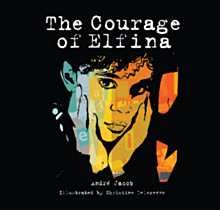The Courage of Elfina by André Jacob
 The Courage of Elfina is the captivating
story of a teen who finds herself in a very adult situation. Elfina lives in
the country on the banks of the Paraguay River. Her mother died in child birth,
while her father is often away working on a large farm in neighbouring Brazil.
Elfina attends the local school and lives with her grandmother. When Elfina
turns twelve, her grandmother tells her that she will be going to the capital
to live with the family of her father’s sister, Evoala. Her wealthy aunt has promised
to enrol Elfina in a good school. But big surprises lie ahead. The family is
not staying in Asunción, but moving to Montreal to operate a clothing import
business. Aunt Evoala also changes Elfina’s name to Elfina Silva Rodriguez so
that she will be like their daughter. But Elfina is never sent to school, nor
is she treated like their daughter. Instead, she becomes their live-in maid and
works around the clock, cooking and cleaning for the family of five. One day, fed
up with the exhausting work and frightening home life, Elfina makes a run for
it and succeeds in turning her life around.
The Courage of Elfina is the captivating
story of a teen who finds herself in a very adult situation. Elfina lives in
the country on the banks of the Paraguay River. Her mother died in child birth,
while her father is often away working on a large farm in neighbouring Brazil.
Elfina attends the local school and lives with her grandmother. When Elfina
turns twelve, her grandmother tells her that she will be going to the capital
to live with the family of her father’s sister, Evoala. Her wealthy aunt has promised
to enrol Elfina in a good school. But big surprises lie ahead. The family is
not staying in Asunción, but moving to Montreal to operate a clothing import
business. Aunt Evoala also changes Elfina’s name to Elfina Silva Rodriguez so
that she will be like their daughter. But Elfina is never sent to school, nor
is she treated like their daughter. Instead, she becomes their live-in maid and
works around the clock, cooking and cleaning for the family of five. One day, fed
up with the exhausting work and frightening home life, Elfina makes a run for
it and succeeds in turning her life around.
The Courage of Elfina is a graphic novel intended for
young adults aged twelve to eighteen who are interested in social issues. The thin,
sixty-four-page graphic novel also comes with information and statistics on
forced child labour and a list of resources and websites for further reading. The
book is intended “for reluctant readers,” which is also the tagline of the
publisher.
The author,
illustrator, and translator of this story make up a stellar cast. Author André
Jacob is a former UQAM professor and a guest lecturer on immigration, racism,
and international development. Christine Delezenne is an award-winning children’s
book illustrator, and Susan Ouriou is also an award-winning literary translator
of more than forty works. However, it is the illustration work by Christine
Delezenne that really takes the reader on Elfina’s journey. Delezenne
skillfully uses a variety of panels to tell Elfina’s story and show the
confines of her real and imaginary worlds in the daily toil of her life as a
maid.
It is a
shame that the illustrator, known for her drawings and their texture, used only
high-contrast black and white illustrations with pale blue halftones for colour.
From the huge mango tree in the Paraguayan countryside, to the city of Asunción
and the red-brick turrets of the family’s Montreal home, this story begs for
colour. A broader palette would have also given the reader some greater
contrast between Elfina’s life in Paraguay and her experience in Montreal. Some
additional hues could have been used to evoke the teen’s psychological state,
like her brief moments of happiness in the grocery store when she sees the
fruit and vegetable displays that remind her of home.
Elfina is a
compelling character that young people should readily identify with. She is
ambitious, and when her personal boundaries are crossed, she pushes back and
rebels. However, even though this story was intended for reluctant readers, the
text itself offers very few opportunities for the reader to truly enter
Elfina’s experience, as in this sentence: “On the bus taking me to the capital,
I felt lost and sad”; or “I let myself fall under the spell of my old
fantasies.” Although the story is written in the first person, the reader knows
little of the sounds, scents, textures, and tastes of Elfina’s world, which
could have easily been done using simple language. In the end, the text feels more
like an outline than a novel.
The Courage of Elfina is an engaging tale to teach young
readers about forced child labour right here in Canada. However, this story
could have a much greater impact if it were fleshed out and if a wider variety
of colours were used in the illustrations. The story itself was gripping, and I
hope that one day it will become a full-length novel or graphic novel.
André Jacob
Translated by Susan Ouriou
Illustrated by Christine Delezenne
James Lorimer and Company Ltd.
$24.95, cloth, 64pp
9781459414198
This review has been cross-posted on the Montreal Review of Books website (mRb).




















